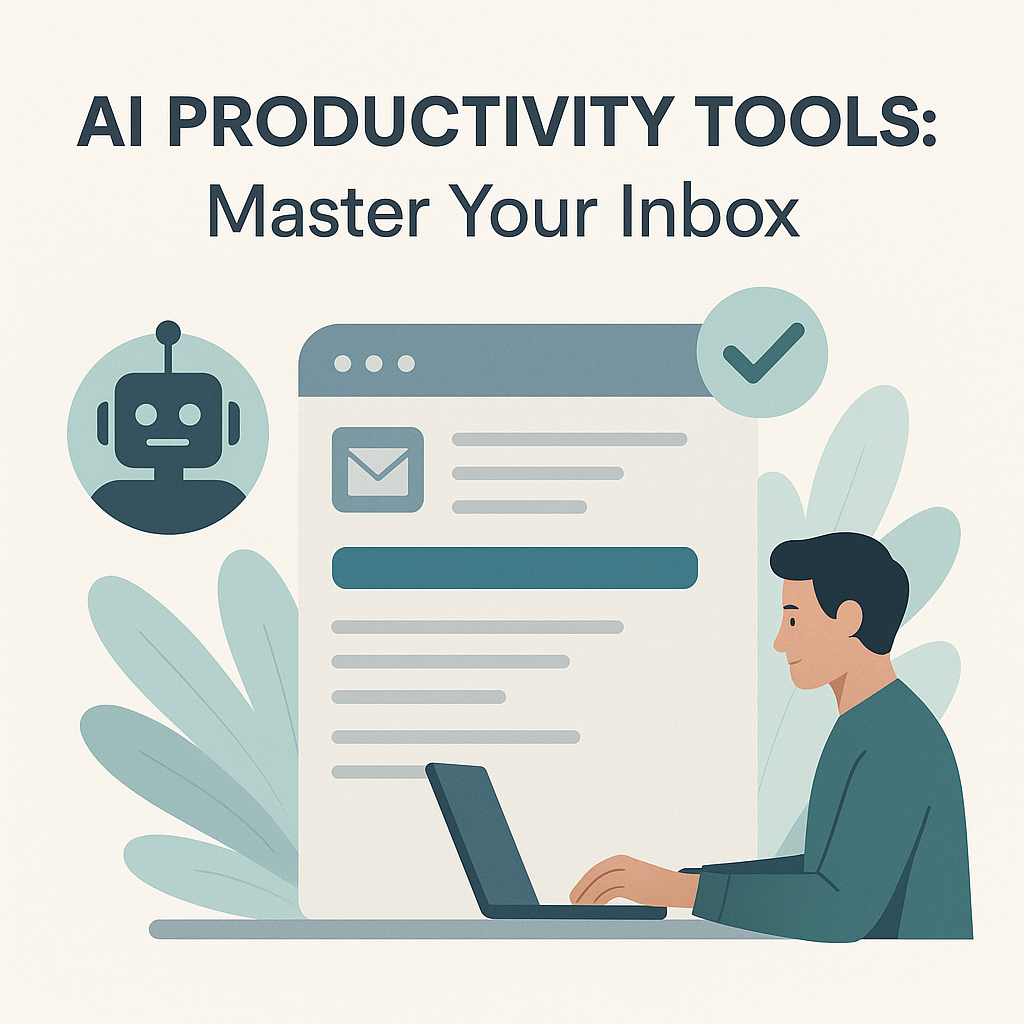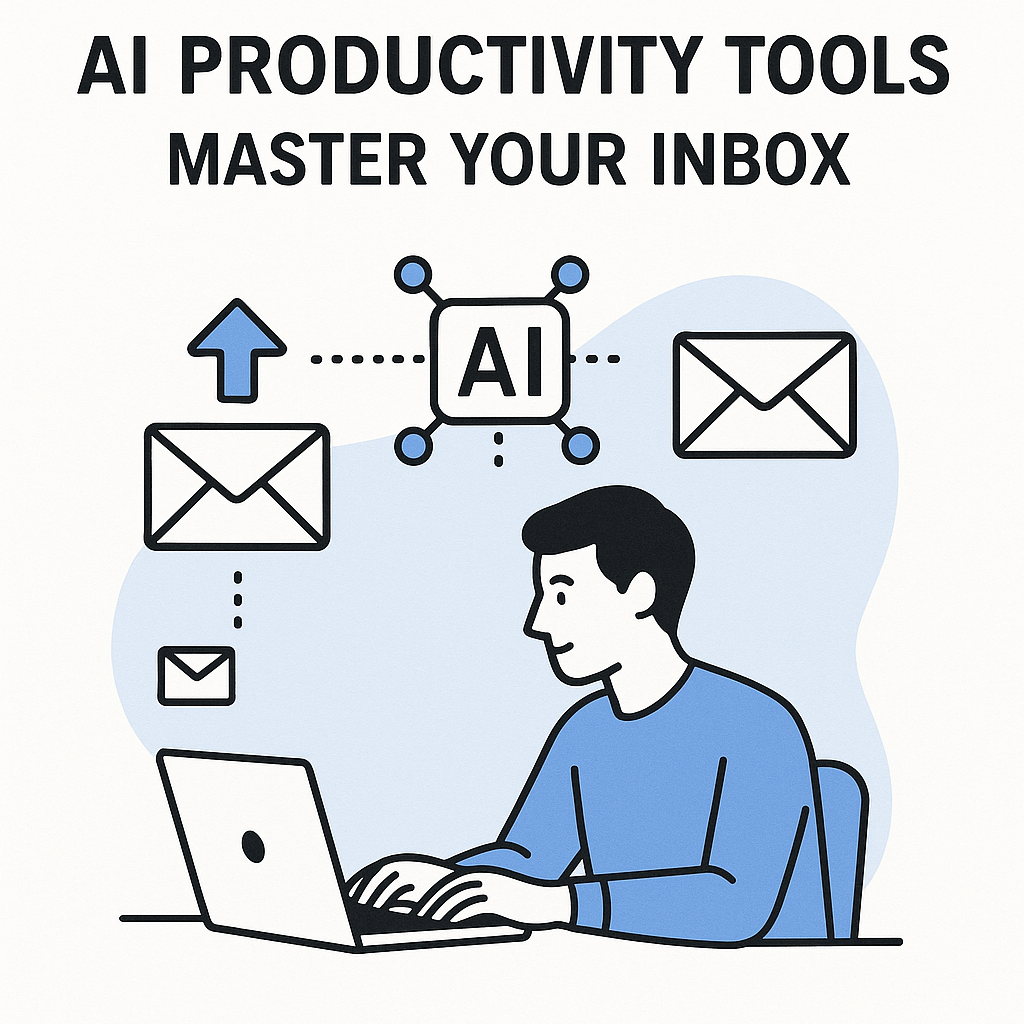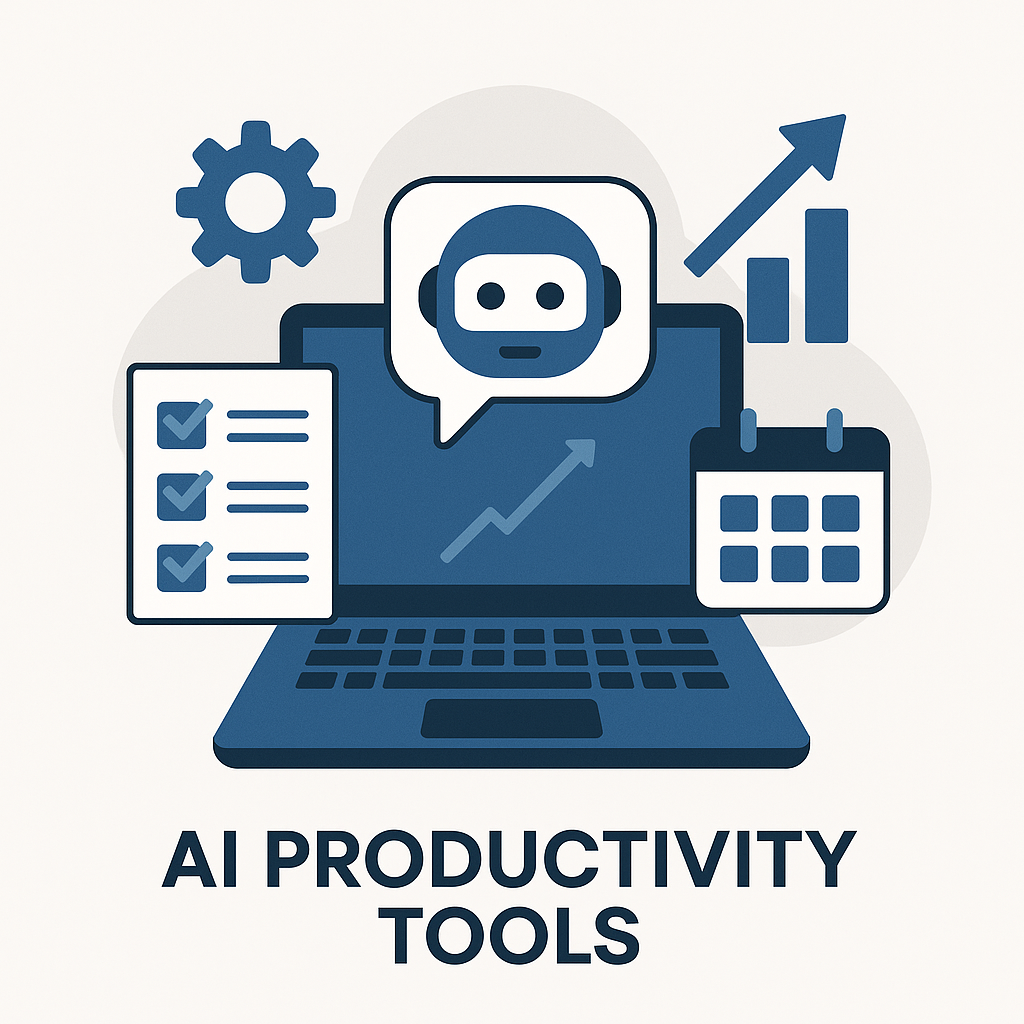AI Productivity Tools: Master Your Inbox

The persistent digital ping, the ever-growing list of unread messages, the feeling of being perpetually behind – for many professionals, entrepreneurs, and teams, the inbox has become a source of stress rather than a tool for efficient communication. We're living in an era of digital overload, where managing email can consume a significant portion of our workday, pulling us away from strategic thinking, creative problem-solving, and deep work. But what if there was a way to reclaim that time and mental energy? Enter the transformative power of AI productivity tools, specifically designed to conquer the email mountain and usher in a new era of business email optimization.
This article dives deep into how artificial intelligence is revolutionizing email management. We’ll explore how these intelligent solutions can automate tedious tasks, intelligently prioritize your communications, help you craft smarter responses, and ultimately free you up to focus on what truly matters. Whether you're an entrepreneur juggling countless responsibilities, a sales professional aiming for better client engagement, or part of a remote team relying on seamless communication, understanding and implementing these tools is key to unlocking unprecedented levels of efficiency.
What Are AI Productivity Tools for Email?
At its core, AI productivity software for email leverages sophisticated artificial intelligence technologies, primarily machine learning (ML) and natural language processing (NLP), to understand, manage, and interact with your email communications in ways previously unimaginable. Unlike traditional email clients or basic filtering rules, AI-powered systems can interpret the content, context, and intent behind your messages.
Think of it this way: traditional filters are like a simple filing cabinet that sorts mail based on sender or subject line. AI, on the other hand, is like an intelligent assistant who reads each piece of mail, understands its urgency, identifies the key information, and knows exactly how to categorize it, who needs to see it, and what action is required. This deeper level of understanding allows AI tools to go far beyond simple sorting, offering capabilities like:
- Intelligent Categorization: Automatically sorting emails into relevant folders (e.g., Urgent, To Read, Follow-up, Project-specific, Spam) based on content and learned patterns, not just sender rules.
- Sentiment Analysis: Detecting the tone of an email, helping you gauge the urgency or emotional context of a message.
- Information Extraction: Pulling out key details like dates, times, action items, or contact information from emails.
- Predictive Assistance: Anticipating your needs, such as suggesting relevant files or contacts based on the email content.
These capabilities represent a significant leap forward from basic email inbox management. By processing vast amounts of data and learning from your interactions, these tools become increasingly personalized and effective over time. For a deeper understanding of the underlying technology, exploring the nuances of email artificial intelligence can provide valuable context.
Key Benefits: Automating Tasks, Prioritization, and Smarter Responses
The integration of AI into email management unlocks a cascade of benefits, directly impacting productivity, efficiency, and even job satisfaction. Let’s break down the core advantages:
Automating Repetitive Tasks
One of the most immediate impacts of AI email tools is the automation of time-consuming, repetitive tasks. This frees up valuable mental bandwidth that can be redirected towards more strategic initiatives.
- Auto-Filing and Archiving: AI can learn your filing habits and automatically move emails to the correct folders, keeping your inbox clean and organized without manual intervention.
- Scheduling and Reminders: Tools can automatically schedule follow-up emails or set reminders for tasks mentioned in emails, ensuring nothing falls through the cracks. This is a core function often handled by a dedicated email automation tools suite.
- Out-of-Office Management: Some AI can even help manage auto-responses or intelligently forward urgent queries to colleagues when you’re unavailable.
- Data Entry: For sales and marketing professionals, AI can extract contact information, deal details, or customer feedback directly from emails and populate CRM systems, streamlining workflows significantly.
By delegating these mundane activities, you reduce the cognitive load associated with email management, allowing for greater focus and less distraction. This is akin to having a digital assistant handle the busywork, a concept explored further in articles about virtual assistant jobs where AI is increasingly taking over routine tasks.
Intelligent Prioritization
In an inbox flooded with hundreds of messages, distinguishing the critical from the trivial can be a daily challenge. AI excels at this, learning to identify what demands your immediate attention.
- Urgency Detection: AI algorithms can analyze keywords, sender reputation, and conversation history to flag emails that require prompt responses or are from high-priority contacts.
- Summarization: For lengthy email threads, AI can generate concise summaries, allowing you to grasp the main points and required actions quickly without reading every single message.
- Sender Importance: Over time, AI learns which senders are most important to you based on your interaction history, subtly boosting their visibility.
- Action Item Identification: AI can scan emails for explicit or implicit action items, creating tasks or reminders automatically, which is crucial for effective email inbox management.
This intelligent prioritization ensures you're always addressing the most critical communications first, improving your responsiveness and reducing the anxiety of missing something vital.
Smarter Responses and Communication
Crafting effective email responses can also be time-consuming. AI tools offer assistance that can dramatically speed up this process while improving the quality of your communication.
- AI-Generated Drafts: Based on the content of incoming emails and your past communication style, AI can generate draft replies, saving you significant typing time. You can then review, edit, and send.
- Smart Reply Suggestions: Many platforms offer quick, context-aware reply suggestions that you can select with a single click.
- Grammar and Tone Checking: Advanced AI can go beyond basic spell-check, offering suggestions for improving clarity, conciseness, and professional tone, ensuring your messages are always polished.
- Auto-Completion and Snippets: AI can learn your frequently used phrases and sentences, offering auto-completion to speed up typing common responses.
These capabilities are particularly valuable for professionals who need to maintain high-volume, high-quality communication, such as AI for sales professionals who rely on prompt and persuasive outreach. The ability to quickly generate and refine responses significantly boosts entrepreneur email efficiency.
For many, the sheer volume and complexity of email necessitate a more advanced approach. Tools like an ai executive assistant can help streamline your workflow by drafting responses, summarizing threads, and managing your communication, allowing you to focus on higher-level tasks.
Choosing the Right AI Email Tool: Features to Look For
With the growing landscape of AI productivity software, selecting the right tool can feel overwhelming. To make an informed decision, consider these key features and functionalities:
- Advanced AI-Powered Sorting & Categorization: Look for tools that offer more than just basic filters. The AI should be able to understand context, identify intent, and learn your preferences for accurate categorization and prioritization. This is a hallmark of effective AI email management.
- Smart Reply & Drafting Assistance: The quality and relevance of AI-generated responses and suggestions are crucial. The tool should ideally adapt to your writing style over time.
- Task Management Integration: Seamless integration with your existing to-do list applications (like Asana, Trello, Todoist) or calendar is vital. This ensures that action items identified in emails are directly translated into manageable tasks.
- CRM Integration: For sales, marketing, and customer support teams, integration with Customer Relationship Management (CRM) systems (like HubSpot, Salesforce) is non-negotiable. This allows for automatic data syncing and a unified view of customer interactions.
- Natural Language Processing (NLP) Capabilities: The stronger the NLP, the better the AI will understand nuances, sentiment, and complex requests within emails. This underpins many of the smart features.
- Scheduling & Follow-up Automation: Features that help you schedule emails for optimal delivery times or automate follow-up sequences are invaluable for maintaining engagement and closing deals.
- Security and Privacy: Given that emails often contain sensitive business information, ensure the tool adheres to strict security protocols and data privacy regulations.
- Customization and Learning: The best AI tools learn from your behavior and allow for customization. The ability to "train" the AI or adjust its settings ensures it aligns with your unique workflow and priorities.
- Cross-Platform Compatibility: Ensure the tool works seamlessly across your devices and operating systems, whether you’re on desktop, mobile, or using multiple email clients.
Exploring comprehensive lists of email management programs can help you identify solutions that meet these criteria. For instance, Unite.AI’s guide to AI email inbox management tools highlights features like optimal send time prediction and CRM integration, which are critical for business success.
Implementing AI Tools into Your Workflow: Practical Steps
Adopting new technology can sometimes feel daunting, but a strategic approach to implementation ensures you maximize the benefits of AI productivity tools for your work email management.
- Assess Your Current Email Pain Points: Before choosing a tool, identify your biggest challenges. Are you drowning in unread emails? Missing follow-ups? Spending too much time drafting responses? Understanding your specific needs will guide your selection.
- Start Small and Pilot: Don't try to implement a complex suite of tools overnight. Begin with a single tool or even a specific feature (like AI-powered sorting or smart replies) and pilot it with a small group or for a limited period. This allows you to test its effectiveness and gather feedback.
- Prioritize Integration: Ensure the chosen AI tool integrates smoothly with your existing technology stack – your CRM, calendar, project management software, and communication platforms. Seamless integration is key to avoiding workflow disruptions.
- Train the AI (and Yourself): Many AI tools learn from your interactions. Spend time labeling emails, categorizing them correctly, and refining AI suggestions. Equally important is training yourself and your team on how to use the tool effectively, understanding its capabilities and limitations.
- Develop Clear Guidelines: If implementing across a team, establish clear guidelines on how to use the AI features. For example, when should an AI-generated draft be used versus a manually written response?
- Monitor Performance and Iterate: Regularly review the tool's performance. Are you saving time? Is your inbox more organized? Are response times improving? Use these metrics to fine-tune settings, explore additional features, or even switch tools if necessary. Continuous improvement is key to long-term success.
- Embrace AI-Augmented Productivity: Encourage a mindset shift where AI is viewed as a partner that handles the routine, allowing humans to focus on complex problem-solving, creativity, and strategic decision-making. This aligns with broader AI-Augmented Productivity Frameworks.
By following these steps, you can effectively integrate AI into your daily routine and transform your relationship with your inbox. For many, this process might involve exploring tools that act as a virtual assistant, helping manage the complexities of modern communication.
AI-Powered Email Management and AI-Augmented Productivity Frameworks
Email remains a central nervous system for many businesses, acting as the primary channel for client communication, internal collaboration, and information dissemination. When this channel is clogged or inefficient, it creates bottlenecks that can hinder overall productivity. This is where AI-powered email management plays a pivotal role within broader AI-Augmented Productivity Frameworks.
These frameworks aim to enhance human capabilities through AI, allowing professionals to operate at a higher strategic level. By automating or streamlining low-value, repetitive tasks – such as sorting emails, drafting standard replies, or scheduling follow-ups – AI frees up significant cognitive resources. This liberated mental space can then be dedicated to:
- Strategic Planning: Developing long-term business strategies, market analysis, and innovation.
- Creative Problem-Solving: Tackling complex challenges that require human ingenuity and critical thinking.
- Relationship Building: Engaging more deeply with clients, partners, and team members through personalized interactions.
- Deep Work: Focusing intensely on tasks that require concentration and uninterrupted thought.
For instance, AI for sales professionals means less time spent on administrative email tasks and more time building rapport, understanding client needs, and closing deals. Similarly, entrepreneurs can leverage AI to manage their overwhelming inboxes efficiently, freeing them to focus on business growth and vision. This shift from administrative burden to strategic focus is the essence of AI-augmented productivity. It's not about replacing human effort but augmenting it, making us more effective and efficient.
Tools that manage email intelligently, like those focusing on email automation tools or smart inbox features, are foundational to these frameworks. They ensure that a core communication channel is optimized, allowing the human element to shine in areas where it adds the most value. This also ties into the evolving landscape of virtual assistant jobs, where AI is not only assisting but also performing tasks that were once exclusively human-led.
Real-World Impact: How AI Transforms Email Productivity
The theoretical benefits of AI in email management translate into tangible, real-world gains for individuals and organizations. Let's look at the practical impact:
Significant Time Savings
The statistics are compelling: professionals can spend anywhere from 2 to 5 hours *per day* managing their email. AI tools can drastically cut this down. By automating sorting, drafting, and follow-ups, an AI email assistant can potentially save users 1-2 hours daily. Imagine reclaiming this time for core business activities, client calls, or strategic planning. For example, an entrepreneur using AI to manage their inbox might reduce their daily email time from three hours to just one, a 67% saving.
Improved Response Times and Quality
With AI handling initial sorting and suggesting/drafting responses, you can reply to emails much faster. Furthermore, AI’s ability to check grammar, tone, and clarity ensures that your communications are professional and effective, enhancing your credibility and improving customer satisfaction. This is particularly critical for businesses focused on lead generation email campaigns, where timely and professional communication can make or break a conversion.
Enhanced Organization and Reduced Stress
A cluttered inbox is a major source of stress and can lead to missed opportunities. AI-powered organization, intelligent prioritization, and automated task management create a sense of order. Knowing that important messages are flagged and routine tasks are handled reduces the mental burden, leading to less burnout and a more focused work environment. Tools that offer smart inbox features are key to achieving this level of organization.
Boosted Sales and Marketing Effectiveness
For sales and marketing teams, efficiency in email is directly tied to revenue. AI can help by:
- Ensuring prompt follow-ups with leads.
- Identifying high-priority leads based on email engagement.
- Automating personalized outreach at scale.
- Providing quick access to customer information from emails within CRM systems.
This level of optimization is crucial for maximizing the impact of cold email strategies and overall lead nurturing.
Hypothetical Case Study: The Startup Founder
Meet Alex, the founder of a growing tech startup. Alex receives over 200 emails daily, ranging from investor updates and vendor inquiries to team communications and customer feedback. Before AI, Alex spent 3-4 hours each day just managing email, often feeling reactive and overwhelmed. Important client requests sometimes got lost in the noise.
Alex implemented an AI email management solution. The AI automatically categorized incoming emails: investor relations, urgent client requests, team updates, marketing inquiries, etc. It learned which senders were high-priority and flagged emails requiring immediate attention. For common questions, the AI drafted suggested replies based on Alex's past responses. It also summarized lengthy internal threads, allowing Alex to quickly grasp key decisions.
The Result: Alex now spends just 1.5 hours per day on email. Response times to critical client inquiries have improved by 40%, and Alex feels more in control, dedicating the saved time to product development strategy and investor relations. This demonstrates the profound impact of AI productivity tools on entrepreneurial efficiency.
For a more detailed look at specific tools, resources like “Top Email Management Programs for AI-Powered Productivity” can offer insights into solutions that integrate advanced AI capabilities.
Conclusion: Embracing AI for a More Productive Inbox
The email overload epidemic is a reality for most professionals, but it doesn't have to be your daily norm. AI productivity tools offer a powerful, intelligent solution to reclaim your time, enhance your focus, and improve your overall communication effectiveness. By automating repetitive tasks, intelligently prioritizing your messages, and assisting with smarter responses, AI transforms your inbox from a source of stress into a streamlined engine for productivity.
Whether you're looking to boost entrepreneur email efficiency, refine your sales outreach, or simply manage your daily communications with less friction, embracing these technologies is a strategic imperative. The insights gained from effective AI email management can ripple outwards, positively impacting your work quality and reducing overall job-related stress. Consider exploring solutions that offer advanced smart inbox features or even integrated capabilities like an ai executive assistant to manage your email communications more effectively.
The future of work is augmented by AI, and mastering your inbox is a critical step in this evolution. Start exploring the tools available today, experiment with their capabilities, and begin your journey towards a more productive, organized, and less stressful email experience. Don't just manage your inbox; master it with the power of AI.
```


